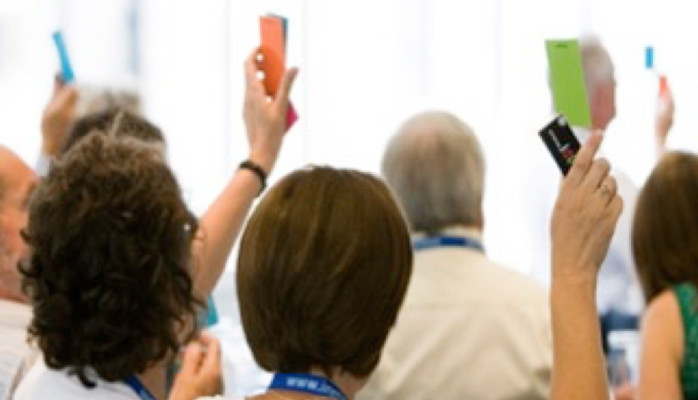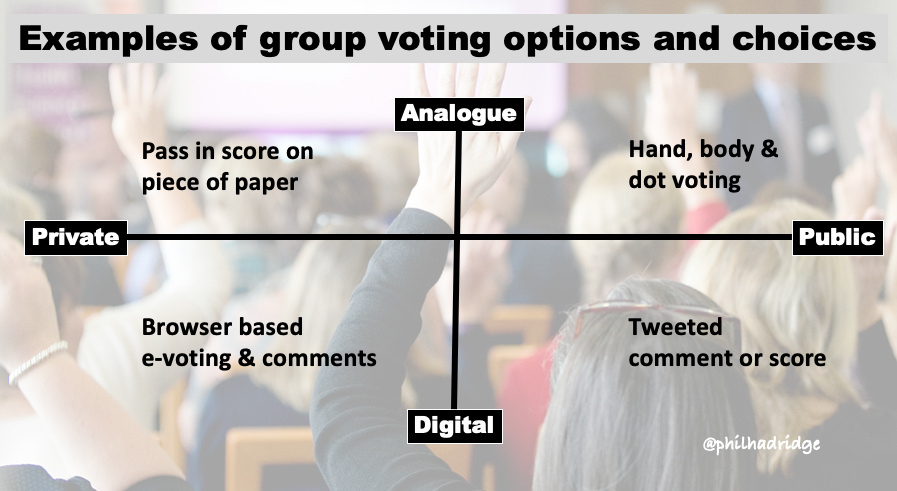
When was the last time you were in a meeting when something was put to the vote? On some Boards and in local to national government there can be a lot of formal voting. Even, in a ‘workshop’ or facilitated meeting voting has a particular usefulness – and can be enjoyable too.
Helping a group of confidently explore the range of opinion in a group is a core facilitation skill. Voting methods help us understand what is on other peoples minds. Whilst sometimes voting is used for decision making, polling methods are of most use for the life and energy they bring to a meeting – both in terms of highlighting certain ideas plus the kinaesthetic action that most votes involve (you have to move something for all of them).
Voting is a useful tool to learn how to deploy – and is suitable for groups of any size, though especially for larger groups where the issue of helping individual ‘voice’ is particularly important and where the meaning of silence can’t be assumed. For example, is it a sign of agreement, difference or even just a pause for reflection?
There are three parts to good voting. You might imagine these as a 3 legged stool, that would topple over without all three parts:
Good questions come from:
Before coming to the second leg of the stool, let's consider the third support of the ‘stool’ - the discussion of the results. This is really important. Even if the question is powerful and useful, and the voting method is engaging and illuminating too, there might be a failure to sufficiently discuss the insights from the results due to time pressures or avoidance.. Alternatively the discussion can go on too long. Voting can really help bring long plenary sessions to life, especially when groups are reporting back - to avoid 'Death by Feedback'.
Voting is often assumed to be useful in helping a group decide – but most organisations and events are not democracies. Some people’s views matter more than others when it comes to agreeing action (the far right of the decision making diamond). However, in a group session voting can help ‘divine’ the group view; the 'wisdom of the crowd'. The purpose here is to inform subsequent thinking and discussion. The opinions that are seen more clearly in a vote give members a chance to re-calibrate their opinion.
So, voting in meetings is most helpful in exploring, not deciding. It might even be useful on ‘process’ issues as well as the core content of meeting. For example, you can test the acceptance of any change to the meeting agenda. For example, using SPOG (summarise, propose, output, gather) you might use a vote to check if some vocal members of the group wanting a new agenda item or approach are representative of the whole.
Now we come to, the second leg (or part) of good voting, and the main focus of this article: choosing the right voting method. Your preference and choice of these will be determined by your personal style and the character and needs of the meeting. Some facilitators (and groups) will hate one, but love another.
There is a whole canvass of options, conveniently summed up in an illustrative two by two matrix:

Expanding a bit, there are a number of low-tech methods to sample opinion. These include:
This is not a definitive list of lower tech options. I’d be interested in the methods you use and can imagine (such as sitting in certain sections of a room, depending on your opinion; signalling your view with your body language).
Some methods favour certain sorts of questions (eg hands up and down for those questions with a few fixed categories, to scales from 1-10 when using fingers or standing on a line).
Most of these are not anonymous. In groups where trust is low, then the insight might be questionable. Also, and more importantly, any method that allows colleagues to see what others think before they declare their result runs the risks of contagion (or groupthink). Asking people to all vote at the same time (when using hands) – or think hard to clarify their thoughts before moving to stick dots or walking standing in a particular place – can help.
Some of the methods require no props, others require some investment and packing in advance (eg voting cards, pre-prepared voting sheets). All voting requires some attention to the necessary ‘kit’ to capture the results and insights – from a camera to pre-prepared slides and spreadsheets to swiftly bring up the results for discussion during the meeting – or to feed back in the record. Even a pen and paper summary of a vote can be interesting when photographed and projected up.
As well as these low tech 'analogue' methods, there are some electronic 'digital' options too:
Beware: these electronic ones can seem attractive (and regularly appeal to leaders who commission events), but tend to cost more and are harder to use ‘in the moment’. They are best used when they can pass the Heineken Test: achieving something no other method can (such as handing complexity, cross tabulation etc).
And note, the GrandDaddy of digital insight, the late Hans Rosling, went a bit analogue with his plastic boxes, having made his name with fancy graphics. Don’t be afraid to keep it simple with methods that are easier to amend and 'busk'.
So, overall, voting provides a way of engaging head, heart and hands – and doing it in a way that helps a group to move through the ‘Decision Diamond’ in interesting, lively and even fun ways.
Finally...which ideas did you find most useful here..."vote now".
When I'm facilitating workshops I often get the participants voting. Sometimes I use "analogue" (voting cards etc) & sometimes "digital" (smartphone voting etc). Here's the most comprehensive article I've read on voting systems: https://t.co/5XY7x4Ehcs Great job @philhadridge pic.twitter.com/KuSpL7sfug
— Helen Bevan (@helenbevan) October 4, 2018
Sign up for updates on our latest thinking via the Business Briefing